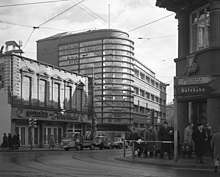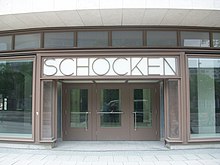Schocken department store
Department store Schocken is the name of several department stores belonging to the former West Saxon retail group I. Schocken Söhne Zwickau . The owners of the department store group were the Jewish brothers Salman and Simon Schocken .
history
founding
On March 18, 1901 in Zwickau , the department store Ury Brothers, Zwickau / Leipzig founded by the brothers Moritz and Julius Ury. Simon Schocken (1874–1929), who had married into the Ury family, was the manager of the department store at Wilhelmstrasse 9 - today Hauptstrasse. In the same year, Salman Schocken joined the business at an offer from his brother Simon Schocken. In 1904 the Schocken brothers founded their first department store at Meinertstrasse 18 in Oelsnitz / Erzgeb . In 1906, the Zwickau department store became the sole property of Simon Schocken, who then founded the I. Schocken Söhne Zwickau company together with Salman Schocken in 1907 . In addition, a purchasing center based in Zwickau was founded, which supplied both department stores.
expansion
Between 1909 and 1913 the company opened department stores in Aue , Planitz , Meißen , Zerbst , Cottbus and Frankenberg . By 1930, Schocken expanded to become the fourth largest department store chain in Germany with a total of 20 branches and Zwickau as the main office. In December 1921 the company was transformed into a partnership limited by shares . The open trading company I. Schocken Sons remained the central purchasing operation of the department stores.
In the 1920s, the Schocken Group developed into one of the most successful department store companies in Germany thanks to the sales and business strategies developed by Salman Schocken, the careful preparation of purchasing, the expansion of efficient production companies and the steady increase in sales in the department stores.
In 1926 the branch was opened at Aufseßplatz in Nuremberg . The building was designed by the well-known architect Erich Mendelsohn in 1925 and was considered a milestone in New Building in Nuremberg.
Erich Mendelsohn also designed the Schocken department store for Stuttgart from 1926 to 1928, opposite the Tagblatt Tower and the Hegelhaus .
On May 15, 1930, a branch of the Schocken Group was opened in Chemnitz . The designs for this building also came from Mendelsohn. It became famous above all for its dynamic-looking facade, whose ribbon windows present themselves as strips of light at night.

Further department stores existed in Auerbach , Augsburg , Bremerhaven , Crimmitschau , Freiberg , Lugau , Pforzheim , Regensburg , Stuttgart , Waldenburg (Silesia) . The company continued to run a shopping center for hosiery, textile workshops, goods inspection offices and purchasing centers in Nuremberg and Berlin .
In November 1933, Schocken KGaA , which at that time had an extensive branch network with more than 30 stores outside Berlin, was converted into a stock corporation with 4.2 million Reichsmark capital and 3.75 million Reichsmark open reserves, the main shareholder of which was Salman Shock was. On October 26, 1929, Simon Schocken, 55, died as a result of a traffic accident. The supervisory board also included his brother Julius Schocken , himself an operator of department stores in the Bremerhaven area, which, however, did not belong to the Schocken Group, but had cooperated for years in the area of personnel training and purchasing.
In German business circles Salman Schocken became known by name because he discussed the basic questions of department stores in writings and lectures and in particular gave the department store idea a theoretical foundation.
In 1936 a British banking group led by Sir Andrew McFadyean took over the majority of the property in order to be considered "Aryanized", while a large minority and part of the property remained in the hands of Salman Schocken.
At the end of 1938, the group was completely “ Aryanized ” through the sale to a German banking group under the leadership of Deutsche Bank AG and Reichs-Kredit-Gesellschaft AG , both based in Berlin, and with it the de facto expropriation. By resolution of the general meeting on December 9, 1938, Schocken AG was renamed Merkur Aktiengesellschaft from January 1939 .
The functionality of the company could be maintained during the war years 1939-1945.
After 1945
With the referendum in Saxony in 1946 , all Saxon branches of Merkur AG were expropriated in favor of the state of Saxony . As a state-owned company, the Saxon stores were subordinated to Industrieverwaltung 64 - department stores and at the end of 1948 they were affiliated to the Association of Saxon Consumer Cooperatives .
The reimbursement of the group to the Schocken family, based on the parts of Merkur AG located in the US occupation zone , took place in 1949. The Schocken family received 51% of the company's share capital. Although the company was already developing positively again, Salman Schocken sold his stake in Merkur AG in 1953 to Merkur, Horten & Co. , headquartered in Nuremberg.
From the Mercury, Horten & Co. later was Horten AG , based in Dusseldorf , later taken over by the Kaufhof AG , which today to Signa Holding belongs.
The name Schocken has been used by the Bremerhaven, Chemnitz, Cottbus, Nuremberg, Regensburg, Stuttgart, Pforzheim and Zwickau populations to this day; For example, the “Club Schocken”, named after the former department store, now exists on Hirschstrasse in Stuttgart.
The Schocken department stores after the war
Oelsnitz / Erzgeb.
After the end of the Second World War, the first Schocken department store became public property . After the political change in 1989/1990, it was transferred back to the Schocken family. From 1999 to 2000 the two buildings were extensively restored.
cottbus
The department store building of the Schocken Group in Cottbus on Spremberger Straße was temporarily the HO department store until the opening of the “Konsument” department store in 1968 . It was demolished in 1980 except for one side wing.
Nuremberg
The building by the well-known architect Erich Mendelsohn , opened in 1926, was destroyed in the air raids on Nuremberg during World War II and replaced by a new building that was completely rebuilt in 1958. After Schocken, the chains Merkur , then Horten , then Kaufhof were represented. In 2013 the building was closed for the time being.
Stuttgart
Erich Mendelsohn's department store building was damaged by bombs during the war and burned down, but could be rebuilt after the war. In 1960 it was approved for demolition by the city of Stuttgart amid large, international protests. The Schocken Club near the former department store therefore got its name.
Chemnitz
The building, erected in 1930 according to Mendelsohn's plans, was reopened in May 2014 as the State Museum of Archeology in Chemnitz , with the original facade design including the Schocken logo being reconstructed in the course of extensive renovation.
Individual evidence
- ^ K. Werner Schulze: Schocken department store in Stuttgart . In: The Bauzeitung united with “Süddeutsche Bauzeitung” Munich, vol. 25, 1928, issue 6, pp. 52–58.
- ↑ ( Page no longer available , search in web archives: Kleine Chronik ) In: CV Zeitung. Volume 8, issue 44 (November 1, 1929), p. 594 and p. 595 (obituary).
- ↑ Judith Breuer, Lost, but not forgotten: the Schocken department store in Stuttgart , in: Denkmalpflege in Baden-Württemberg , Vol. 48 No. 3 (2019), pp. 147-160
- ↑ Diginights about the Schocken Club
- ↑ smac.sachsen.de ( Memento from July 21, 2015 in the Internet Archive )
- ↑ Erich Mendelsohn's Schocken department store in Chemnitz . Retrieved July 13, 2014.
literature
- Konrad Fuchs: A company from Saxony. The Schocken department store as a reflection of German economy and politics 1901–1953. Deutsche Verlags-Anstalt, Stuttgart 1990, ISBN 3-421-06581-0
- Hans-Eberhard Happel u. a .: Shock a German story. Bremerhaven 1994, ISBN 3-927857-53-X
- Anthony David: The Patron. A Life of S. Schocken 1877-1959. Metropolitan Books, New York 2003. (Critical review by Michael Brocke in: Kalonymos. Contributions to German-Jewish history from the Salomon Ludwig Steinheim Institute, Issue 9 1/2006, pp. 6f ISSN 1436-1213 ). There also main article about shock. The book was also published in Hebrew. Schocken, Tel Aviv 2006
- Norbert Peschke : The Zwickauer Schocken Group . In: Sächsische Heimatblätter . Journal for Saxon history, monument preservation, nature and the environment. No. 47 , 2001, ISSN 0486-8234 , p. 319-332 .
To individual department stores
Chemnitz
- Werner Hegemann : Erich Mendelsohn's Schocken-Chemnitz department store. In: Wasmuth's monthly magazine for architecture. Vol. 14, No. 8 (1930), urn : nbn: de: kobv: 109-opus-8577 , pp. 345–356 (nine illustrations)
- Christian Schönwetter, State Museum for Archeology in Chemnitz. Loss-making profit , in: Deutsche Bauzeitung , 09/2014, November 30, 2014, accessed on August 20, 2019
- Jürgen Nitsche: The Schocken department store in Chemnitz - history and material world. In: Sächsische Heimatblätter . 60 (2014) 4, pp. 386-395.
- Werner Jacob: The unsustainable lightness of stone. Erich Mendelsohn's Schocken department store in Chemnitz. In: Frankfurter Allgemeine Zeitung. April 30, 1999, No. 100, p. 49, accessed April 8, 2011.
- Tilo Richter: Erich Mendelsohn's Schocken department store. Jewish cultural history in Chemnitz. Passage-Verlag, Leipzig 1998, ISBN 3-9805299-5-9 .
cottbus
- Lars Scharnholz: Department Store Schocken Cottbus. Diekmann, 2000, ISBN 3-9807225-0-3 .
Nuremberg
- A piece of department store history comes to an end. Nürnberger Zeitung, June 16, 2012, accessed on February 6, 2013 .
- Picture gallery on nordbayern.de from June 14, 2011: The Kaufhof at Aufseßplatz - a chronicle.
Stuttgart
- Wolfgang Müller: Stuttgart in old views. Zaltbommel 1979, No. 60, 61.
- Ignaz E. Hollay: … getting on in years. Shock ... Mercury ... hoarding. The 60 years of a Stuttgart department store . In Deutsche Bauzeitung 122.1988, issue 9, pp. 102–112.
- Renate Palmer: The Stuttgart Schocken Building by Erich Mendelsohn. The story of a department store and its architecture. 1995, ISBN 3-87407-209-6 .
- Petra Ralle: Consistent demolition. The (in) avoidable end of the Schocken department store by Erich Mendelsohn in Stuttgart (= publications of the Stuttgart City Archives. Volume 90.) Hohenheim, Stuttgart, 2002, ISBN 3-89850-974-5 .
- Uwe Bogen (text); Thomas Wagner (photos): Stuttgart. A city changes its face. Erfurt 2012, pp. 30–31.
- Judith Breuer, Lost, but not forgotten: the Schocken department store in Stuttgart , in: Denkmalpflege in Baden-Württemberg , Vol. 48 No. 3 (2019), pp. 147-160
Web links
- State Archives Chemnitz: Schocken Group & Successors, Zwickau
- Cambridge University research project
- Expansion, example, exile: On the trail of the Zwickau department store kings Schocken
- The department store group Schocken (Shalom project: Jews in Central Saxony)
Coordinates: 48 ° 46 '24 " N , 9 ° 10' 33" E




